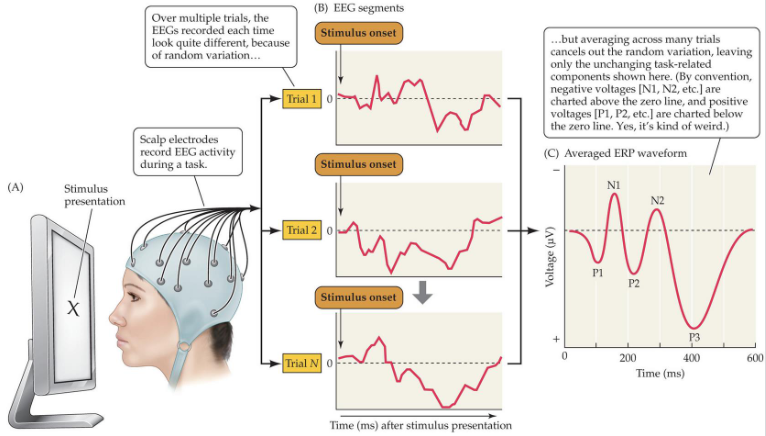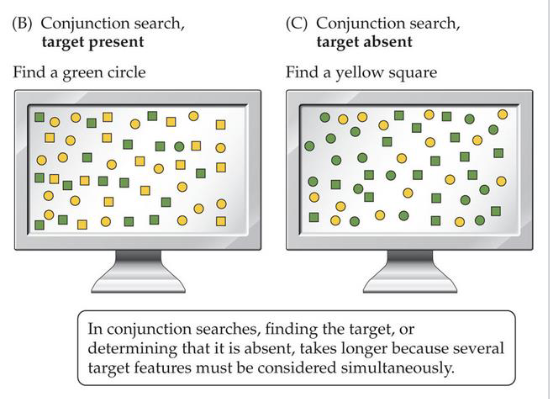Chapter 14: Attention
1/51
Earn XP
Description and Tags
Made by @agreyr
Name | Mastery | Learn | Test | Matching | Spaced |
|---|
No study sessions yet.
52 Terms
Consciousness
The state of being aware that we are conscious and that we can perceive what is going on in our minds and around us
Brain regions implicated in consciousness
Default Mode Network & Claustrum
Default Mode Network
Circuit of brain regions active during quiet introspective thought (frontal, parietal, and temporal regions)
Claustrum
Sheets of neurons in the forebrain (lateral to the basal ganglia)
Elements of consciousness
Theory of mind, mirror recognition, imitation, empathy & emotion, tool use, language, and metacognition
Theory of mind
Understanding others have their own beliefs, knowledge, and desires
Mirror recognition
Ability to recognize the self as depicted in a mirror
Imitation
Ability to copy the actions of others; may be important for empathy and self-awareness
Empathy & emotion
The ability to imagine the feelings of other individuals
Tool use
Ability to employ objects to achieve goals
Language
Use of a system of arbitrary symbols, with specific meanings and strict grammar, to convey information to other individuals
Metacognition
The ability to “think about thinking”
Executive functions
Higher-level cognitive processes that control and organize our thoughts, behaviors, and feelings
Task switching, working memory, inhibition of thoughts/behaviors, thought suppression, and monitoring of ongoing performance (ex: delay of gratification)
Prefrontal cortex responsible for working memory and task switching
Hemispatial Neglect
Individuals ignore stimuli on the left side of their midline; these individuals usually have normal vision, may ignore people and objects; lesions in the frontoparietal attention network
Bálint’s Syndrome
Characterized by bilateral parietal lobe damage; includes oculomotor apraxia, optic ataxia, and simultagnosia
Oculomotor apraxia
Unable to appropriately direct visual gaze horizontally
Optic ataxia
Cannot reach for objects using visual cues
Simultagnosia
Only one object or feature consciously observed at a time
Superior Colliculus
Controls eye movement toward objects of attention; helps direct covert attention
Two major pathways to select and shift attention
Dorsal frontoparietal and right temporoparietal
Dorsal frontoparietal
Top-down, voluntary attention; includes IPS and FEF
Intraparietal sulcus (IPS)
Increased rate of firing of neurons when attention is directed to specific stimuli; can be visual or auditory stimuli; important for steering attention; damage can make voluntary shifts of attention difficult
Frontal eye field (FEF)
Damage results in inability to ignore distractors in periphery; important for gaze being directed at stimuli according to cognitive goals (a top-down process)
Right temporoparietal
Bottom-up, reflexive attention; includes TPJ
Temporoparietal junction (TPJ)
Meeting of the temporal and parietal lobes in right hemisphere; directs attention toward new or unexpected stimuli; stimuli will elicit a spike in the neural activity of this region regardless of location of stimulus in the environment (right vs left visual field); direct input from visual cortex
Measuring attention
When attending to a task, cortical neuron activity becomes synchronized; measured through an EEG, average results over many trials of task completion
Event-Related Potential (ERPs)
Averaged EEG recordings measuring brain responses to repeated presentations of a stimulus
Measuring ERPs
Stimulus presentation —> EEG segments —> averaged ERP waveform

Patterns in shifts of attention
Regarding auditory stimuli, shadowing has a predictable effect on the ERP; two large waves from the auditory cortex, initial positive wave (P1) followed by negative wave (N1)
Differences in ERPs for stimuli attended to, as opposed to stimuli not attended to
Auditory N1 effect
Negative N1 much larger for stimuli attended to; likely measuring the result of selective attention acting on neural mechanisms to enhance the processing of sound stimuli
P3 Effect
The positive wave seen about 300 ms after the stimulus; associated with memory, responses to surprise events, and higher order processing (meaning, language, identity of speaker, etc.)
Shadowing experiments
Participants focus their attention to one of two streams of stimuli (dichotic listening)
Dichotic listening
Focus on one ear and repeat the message
Inattentional blindness
The failure to perceive stimuli that are not actively being attended to
Change blindness
A visual perception phenomenon where people fail to notice a change in a visual scene
Divided attention
The act of processing two or more stimuli at the same time; attention is limited
Attention acts as a spotlight; helps focus our cognitive resources, direct our behavior, and tunes out extraneous information
Perceptual load
Processing demands imposed by the task
When the task is easy: resources left over to process task-irrelevant stimuli
When the task is difficult/complex: no more resources to spare; extra stimuli excluded immediately
Categories of attention
Sustained, voluntary, and reflexive
Sustained attention
Stimulus or location is held in the attentional spotlight for a prolonged period of time; measures basic attentional abilities
Voluntary attention
Voluntary; conscious, top-down; in line with goals; endogenous
Reflexive attention
Involuntary; bottom-up process; mediated by lower levels of the nervous system; exogenous
Feature search
Search for a target based on a unique attribute

Conjunction search
Search for a target on the basis or a combination of features

Binding problem
Question of how the brain understands which individual attributes blend together into a single object, when these different features are processed by different regions in the brain
Selective attention
Process by which we select or focus on one or more stimuli for enhanced processing and analysis
Vigilance
A global level of alertness of the individual
Overt attention
Attention in which the focus coincides with sensory orientation
Covert attention
Attention in which the focus can be directed independently of sensory orientation
Cocktail party effect
Selective enhancement of attention in order to filter out distractions
Attentional bottleneck
Attention acts as a filter so our resources are directed to what is MOST important

Early selection models (when does this bottleneck occur?)
Unattended information is filtered out right away, at the level of sensory input; the meaning is not yet processed and the filter only lets through information based on physical characteristics of the information

Late selection models (when does this bottleneck occur?)
All incoming stimuli are processed for meaning before any selection occurs for attention; no feature-based filtering occurs
